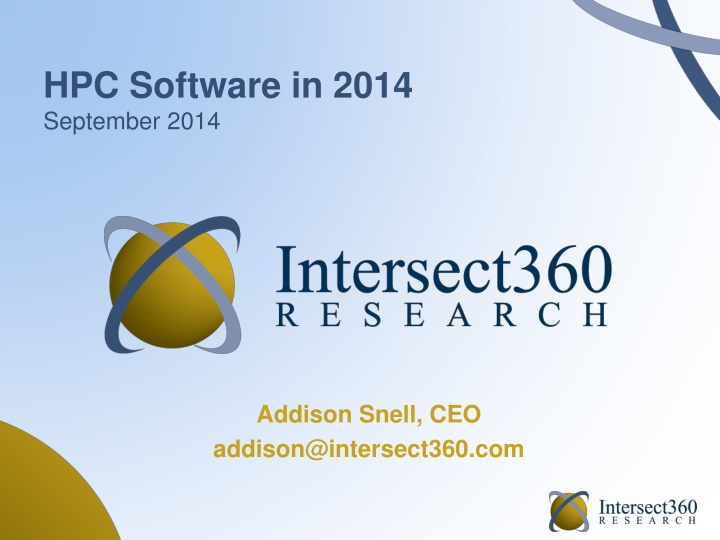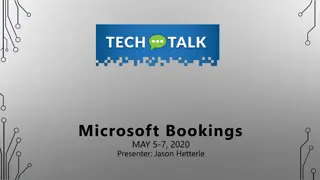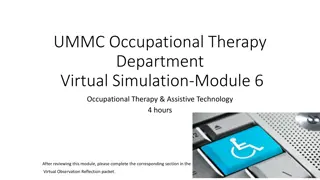
Insights into High Performance Computing Software Studies in 2014
Discover key insights on HPC software studies in 2014, including trends in commercial markets, the impact of Big Data, the rise of open source, and the critical role of software in scalability.
Download Presentation

Please find below an Image/Link to download the presentation.
The content on the website is provided AS IS for your information and personal use only. It may not be sold, licensed, or shared on other websites without obtaining consent from the author. If you encounter any issues during the download, it is possible that the publisher has removed the file from their server.
You are allowed to download the files provided on this website for personal or commercial use, subject to the condition that they are used lawfully. All files are the property of their respective owners.
The content on the website is provided AS IS for your information and personal use only. It may not be sold, licensed, or shared on other websites without obtaining consent from the author.
E N D
Presentation Transcript
HPC Software in 2014 September 2014 Addison Snell, CEO addison@intersect360.com
Technical vs. Enterprise Computing Technical Computing Top-line missions: Find the oil Design the minivan Cure the disease Driven by price/performance Fast adoption of new technologies, algorithms, and approaches Enterprise Computing Keeps business running Communicate/collaborate Market and sell the product Accounting, HR, finance, Driven by RAS: reliability, availability, serviceability Slow adoption of new technologies, algorithms, and approaches
Where We Find HPC High Performance Technical Computing (HPTC) Applications in science and engineering Top markets: academia, government labs, defense, manufacturing, bio/life science, oil/gas exploration High Performance Business Computing (HPBC) Applications include trading, pricing, risk management, logistics, fraud detection, online games, analytics, Top markets: financial services, ultrascale internet, online games, retail, entertainment
HPTC and HPBC Vertical Markets HPTC Total Market (2012 rev., 70%) by Vertical HPBC Total Market (2012 rev., 30%) by Vertical 24% Acad. 41% Comm. 35% Govt. Financial services and manufacturing (auto/aero plus consumer) are about equal Worldwide, private sector is growing faster than public sector 2013 data available to clients
Major HPC Software Studies in 2014 Annual HPC User Site Census: Installation data including middleware and application software Annual HPC User Budget Map: Budget data showing percent of spending by category Special Study: The Big Data Opportunity for HPC, surveyed both HPC and non-HPC enterprises on Big Data applications and infrastructures Council on Competitiveness: Solve. The Exascale Effect: the Benefits of Supercomputing Investment for U.S. Industry (pending release)
Key Insights 1. HPC usage in commercial markets is growing, with expanding application categories Commercial growing faster than public sector Big Data provides a breakout opportunity for HPC 2. Open-source is on the rise Driven by pricing models and new categories Includes increase in business computing 3. Software is the most critical limiting factor in scalability New models of parallelism (multi-core, many-core) Middleware, developer tools are important investments
Total HPC Market Revenue ($K) Cloud small ($613M in 2013), but fast-growing (18.6% CAGR) $38.1B in 2018 4.6% CAGR $30.5B in 2013 Servers largest segment ($10.9B in 2013), followed by software ($6.5B)
2013 Market Performance Table 3: 2013 vs. 2012 Comparison Total HPC Market Revenue ($, millions) by Product Class Product Class 2012 Servers 10,744 Storage 4,735 Services 3,238 Software 6,333 Networks 2,084 Cloud 582 Other 2,034 Total 29,749 2013 was fourth consecutive year of growth for the market but shows a marked decline in growth rate. By segment: Government : Down 2.4% Academia: Commercial: Up 4.6% HPBC: HPTC: 2013 10,943 4,625 3,414 6,497 2,291 613 2,109 30,491 Source: Intersect360 Research, 2014 Change Growth 1.8% -2.3% 5.4% 2.6% 9.9% 5.4% 3.7% 2.5% 198 (110) 176 164 207 31 75 742 Up 2.9% Up 4.5% Up 1.6% Note on Storage: 2013 is the first normal year after the flooding in Southeast Asia in the second half of 2011, which caused a significant amount of revenue to be deferred from 2011 and recognized in 2012. Therefore, 2011 storage revenue was artificially low, and 2012 was artificially high. Storage revenue has seen 7.4% CAGR since 2010.
Top Overall Application Categories Surveys conducted in the last three years 1,108 primary applications were reported by 435 HPC sites Three-fourths of the mentions were HPTC applications and one- fourth were HPBC applications About 80% of the 496 unique application packages had only one mention Figure 1. Top 10 Primary Application Categories, Total Sites N = 1,076 mentions
HPC Site Census: Applications Figure 2. Top Primary Application Categories by Super Segments, Total Sites HPTC HPBC N = 798 mentions N = 266 mentions
HPC Site Census: Applications Figure 3. Supplier Type for Primary Applications, Total Sites N=1,107 Mentions
Types of Primary Middleware Reported >300 unique packages reported over half (62%) only mentioned once Includes mathematical packages, e.g. Mathworks Academic bias, but strong across all segments Everyone needs a compiler N = 1,252 mentions
HPC Middleware by Sector Very little middleware is developed in-house Middleware is still a focus of academic research and therefore, open- source middleware is very prevalent Middleware has a much broader target market than application software. Middleware functionality, efficiency, and reliability impact every user of the computer system while an application impacts a subset of users, and sometimes only one user.
Changes in the CFD Landscape CFD Software by Source by Survey Year
Big Data: Much More than Hadoop Sources of Big Data applications In-house Purchased Open-source Unknown Number of applications Number of respondents Intersect360 Research, 2013-2014 Business Technical Total 49 45 35 1 37.7% 130 34.6% 26.9% 0.8% 130 51.0% 179 16.9% 30.2% 112 2.0% 255 46.5% 22.9% 29.1% 1.6% 385 43 77 5 88 6 59 139 198 Big Data is predominantly in-house applications Notable change from prior year: Non-HPC sites adopting more open-source
Software in Commercial HPC Source: Solve. The Exascale Effect: Benefits of Supercomputing Investment for U.S. Industry, new report pending publication, with U.S. Council on Competitiveness
Barriers to Scalability Source: Solve. The Exascale Effect: Benefits of Supercomputing Investment for U.S. Industry, new report pending publication, with U.S. Council on Competitiveness
Effects of Many-Core Accelerator penetration has almost doubled from previous year Average number of accelerators configured per system has nearly tripled 60 to 175
Effects on Skills Required Skill sets need to evolve What does it mean to be a programmer? What does it mean to be a sys admin? Industry finds a shortage of skilled talent Those who know both HPC and science / engineering are highly valued individuals
Working with Intersect360 Research If you are an HPC vendor: We d love to have you as a client Advisory/consulting, data and insights, plus whitepapers, webinars, podcasts, etc. Brief us any time If you are an HPC user: Free access to research if you participate See www.hpc500.com to join user group Custom work for users also available Sign up for updates at www.intersect360.com
Questions Actionable Market Intelligence for High Performance Computing






















